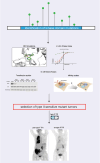Responsiveness of different MET tumour alterations to type I and type II MET inhibitors
- PMID: 40437874
- PMCID: PMC12120261
- DOI: 10.1002/ctm2.70338
Responsiveness of different MET tumour alterations to type I and type II MET inhibitors
Abstract
Background: Mutations in c-MET receptor tyrosine kinase (MET) can be primary oncogenic drivers of multiple tumour types or can be acquired as mechanisms of resistance to therapy. MET tyrosine kinase inhibitors (TKIs) are classified as type I or type II inhibitors, with the former binding to the DFG-in, active conformation of MET, and the latter to the DFG-out, inactive conformation of MET. Understanding how the different classes of MET TKIs impact tumours with varied MET alterations is critical to optimising treatment for patients with MET altered cancers. Here, we characterise MET mutations identified in patients' tumours and assess responsiveness to type I and II TKIs.
Methods: We used structural modelling, in vitro kinase and in cell-based assays to assess the response of MET mutations to type I and II TKIs. We then translated our pre-clinical findings and treated patients with MET mutant tumours with selected inhibitors.
Results: We detected the emergence of four (three previously uncharacterised and one known) MET resistance mutations (METG1090A, METD1213H, METR1227K and a METY1230S) in samples from patients with multiple solid tumours, including patients who had been previously treated with type I inhibitors. In silico modelling and biochemical assays across a variety of MET alterations, including the uncharacterised METG1090A and the METY1230S substitutions, demonstrated impaired binding of type I but not of type II TKIs (i.e., cabozantinib/foretinib). Applying our pre-clinical findings, we then treated two patients (one with a non-small-cell lung cancer and one with a renal cell carcinoma) whose tumours harboured these previously uncharacterised MET alterations with cabozantinib, a type II MET TKI, and observed clinical responses.
Conclusions: Comprehensive characterisation of the sensitivity of mutations to different TKI classes in oncogenic kinases may guide clinical intervention and overcome resistance to targeted therapies in selected cases.
Key points: Kinase mutations in RTKs are primary or secondary drivers in multiple cancer types Some of these mutations confer resistance to type I but not to type II inhibitors in preclinical samples and in patients The biochemical characterization of mutations in oncogenic kinases based on their sensitivity to type I and type II inhibitors is crucial to inform clinical intervention.
Keywords: MET; resistance to targeted therapy; type I and type II TKIs.
© 2025 The Author(s). Clinical and Translational Medicine published by John Wiley & Sons Australia, Ltd on behalf of Shanghai Institute of Clinical Bioinformatics.
Conflict of interest statement
Yonina R. Murciano‐Goroff reports travel, accommodation and expenses from AstraZeneca and Loxo Oncology/Eli Lilly. She acknowledges honoraria from Virology Education and Projects in Knowledge (for a CME program funded by an educational grant from Amgen). She has been on an advisory board for Revolution Medicines, and consulted for AbbVie. She acknowledges associated research funding to the institution from Mirati Therapeutics, Bristol Myers Squibb/E.R. Squibb & Sons, Loxo Oncology at Eli Lilly, Elucida Oncology, Taiho Oncology, Hengrui USA, Ltd/Jiangsu Hengrui Pharmaceuticals, Luzsana Biotechnology, Endeavor Biomedicines and AbbVie. She is an employee of Memorial Sloan Kettering Cancer Center, which has an institutional interest in Elucida. She acknowledges royalties from Rutgers University Press and Wolters Kluwer. She acknowledges food/beverages from Endeavor Biomedicines, and other services from Amgen, AbbVie and Loxo Oncology/Eli Lilly. Yonina R. Murciano‐Goroff acknowledges receipt of training through an institutional K30 grant from the NIH (CTSA UL1TR00457). She has received funding from a Kristina M. Day Young Investigator Award from Conquer Cancer, the ASCO Foundation, endowed by Dr. Charles M. Baum and Carol A. Baum. She is also funded by the Fiona and Stanley Druckenmiller Center for Lung Cancer Research, the Andrew Sabin Family Foundation, the Society for MSK, the Squeri Grant for Drug Development and a Paul Calabresi Career Development Award for Clinical Oncology (NIH/NCI K12 CA184746) as well as through NIH/NCI R01 CA279264. Zsofia K. Stadler has intellectual property rights in SOPHiA Genetics and serves as an Associate Editor for JCO Precision Oncology and as a Section Editor for UpToDate. Zsofia K. Stadler's immediate family member serves on the Board of Directors for Adverum Biotechnologies, is Co‐Founder, CMO and President for Blue Gen Therapeutics Foundation, and serves as a consultant in Ophthalmology for Apellis, Novartis, Outlook Therapeutics, Optos and Regeneron outside the submitted work. Michael F. Berger acknowledges personal fees (AstraZeneca, Paige.AI), Research Support (Boundless Bio), Intellectual Property Rights (SOPHiA Genetics). Eneda Toska has grants from AstraZeneca and consulting fees from Menarini. Srinivasaraghavan Kannan and Chandra S. Verma are founder directors of SiNOPSEE Therapeutics and Aplomex. Alexander Drilon declares: HONORARIA: 14ner/Elevation Oncology, Amgen, Abbvie, AnHeart Therapeutics, ArcherDX, AstraZeneca, Beigene, BergenBio, Blueprint Medicines, Bristol Myers Squibb, Boehringer Ingelheim, Chugai Pharmaceutical, EcoR1, EMD Serono, Entos, Exelixis, Helsinn, Hengrui Therapeutics, Ignyta/Genentech/Roche, Janssen, Loxo/Bayer/Lilly, Merus, Monopteros, MonteRosa, Novartis, Nuvalent, Pfizer, Prelude, Regeneron, Repare RX, Springer Healthcare, Takeda/Ariad/Millennium, Treeline Bio, TP Therapeutics, Tyra Biosciences, Verastem, Zymeworks; ADVISORY BOARDS: Bayer, MonteRosa, Abbvie, EcoR1 Capital, LLC, Amgen, Helsinn, Novartis, Loxo/ Lilly, AnHeart Therapeutics, Nuvalent; CONSULTING: MonteRosa, Innocare, Boundless Bio, Treeline Bio, Nuvalent, 14ner/Elevation Oncology, Entos, Prelude; COPYRIGHT: Selpercatinib‐Osimertinib (filed/pending); EQUITY: mBrace, Treeline; ASSOCIATED RESEARCH PAID TO INSTITUTION: Foundation Medicine, GlaxoSmithKline, Teva, Taiho, PharmaMar; OTHER: Merck, Puma, Merus, Boehringer Ingelheim; ROYALTIES: Wolters Kluwer, UpToDate; CME HONORARIA: Answers in CME, Applied Pharmaceutical Science, Inc, AXIS, Clinical Care Options, Doc Congress, EPG Health, Harborside Nexus, I3 Health, Imedex, Liberum, Medendi, Medscape, Med Learning, MedTalks, MJH Life Sciences, MORE Health, Ology, OncLive, Paradigm, Peerview Institute, PeerVoice, Physicians Education, Projects in Knowledge, Resources, Remedica Ltd, Research to Practice, RV More, Targeted Oncology, TouchIME, WebMD; Emiliano Cocco declares: RESEARCH FUNDS: InnoCare Pharma, ERASCA and Prelude. Emiliano Cocco is also a consultant for ENTOS, Inc.
Figures





References
-
- Bradley CA, Salto‐Tellez M, Laurent‐Puig P, et al. Targeting c‐MET in gastrointestinal tumours: rationale, opportunities and challenges. Nat Rev Clin Oncol. 2017;14:562‐576. - PubMed
MeSH terms
Substances
Grants and funding
LinkOut - more resources
Full Text Sources
Medical
Miscellaneous
